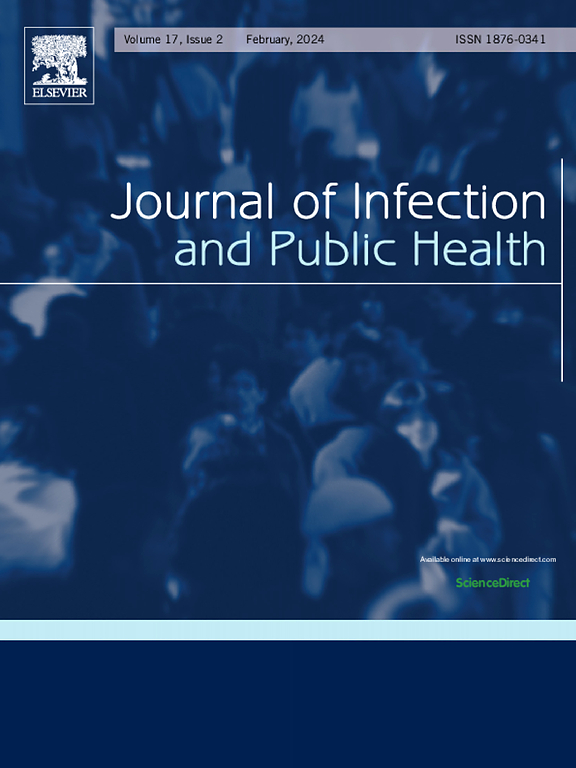Synergistic antifungal effect of naturally-derived antimicrobials with penetration enhancer against Candida albicans biofilm at 5 °C and 22 °C
IF 4
3区 医学
Q1 INFECTIOUS DISEASES
引用次数: 0
Abstract
Background
Biofilms of fungi such as Candida albicans (C. albicans) can survive even at cold temperatures and are generally difficult to eradicate with well-known antimicrobials. The aim of this study was to develop a novel synergistic technique against C. albicans biofilms using low concentrations of propylene glycol (PG), as a penetration enhancer. It helps naturally-derived antimicrobials [caprylic acid (CA) and carvacrol (CAR)] permeate C. albicans biofilms and cell membranes within short times even in cold environments.
Methods
C. albicans biofilms formed on stainless steel coupons were treated with antifungal complexes (PG, CA and CAR at 0.6–1.2 mM) for 1 or 5 min at 5 and 22°C. PG was selected as the highest fungicidal efficacy, as well as its odourless, colourless nature and excellent solubility compared to other penetration enhancers (isopropyl citrate, laurocapram). To visualize cell damage by antifungal complex, treated biofilms at 5°C and 22°C were examined using the confocal microscopy and field emission scanning electron microscopy.
Results
Each substance (PG, CA, CAR), when applied alone to C. albicans biofilms for 5 min, showed less than 0.50 log reduction at both 5 and 22°C. C. albicans biofilm was completely eradicated by PG + CA + CAR (all 1.2 mM) after 5 min at 5 and 22°C (> 6.20 log reduction), but treatment mixtures without PG were incompletely eliminated after 1 min at 5°C (1.75 log reduction) and 22°C (3.75 log reduction). Based on the visualization of biofilms, PG + CA + CAR (all 1.2 mM) resulted in remarkable membrane disruption and cell detachment from stainless steel coupons in contrast to the other treatment conditions.
Conclusion
This study indicates that trace amounts of developed antifungal complex could be an effective way to inactivate fungal biofilms on the surfaces of the medical and healthcare field even at cold temperatures.
含渗透增强剂的天然抗菌药物在5 °C和22 °C条件下对白色念珠菌生物膜的协同抗真菌作用
真菌的生物膜,如白色念珠菌(C. albicans)即使在低温下也能存活,并且通常难以用众所周知的抗菌剂根除。本研究的目的是开发一种新的协同技术,利用低浓度的丙二醇(PG)作为渗透增强剂,对抗白色念珠菌生物膜。它有助于天然来源的抗菌剂[辛酸(CA)和香芹酚(CAR)]在短时间内渗透白色念珠菌的生物膜和细胞膜,即使在寒冷的环境中也是如此。在不锈钢片上形成的白色念珠菌生物膜用抗真菌配合物(PG, CA和CAR, 0.6-1.2 mM)在5°和22°C下处理1或5 min。与其他渗透增强剂(柠檬酸异丙酯、月桂酰胺)相比,PG的杀菌效果最高,且其无臭、无色、溶解度好。为了观察抗真菌复合物对细胞的损伤,使用共聚焦显微镜和场发射扫描电镜检查了5°C和22°C下处理过的生物膜。结果每一种物质(PG、CA、CAR)单独作用于白色念珠菌生物膜5 min时,在5°C和22°C下,其还原量均小于0.50 log。5 min后,PG + CA + CAR(均为1.2 mM)在5°C和22°C (>;6.20 对数减少),但不含PG的处理混合物在5°C(1.75 对数减少)和22°C(3.75 对数减少)下1 min后不完全消除。根据生物膜的可视化,与其他处理条件相比,PG + CA + CAR(均为1.2 mM)导致显著的膜破坏和细胞脱离不锈钢片。结论微量抗真菌复合物在低温条件下也能有效灭活医疗卫生领域表面的真菌生物膜。
本文章由计算机程序翻译,如有差异,请以英文原文为准。
求助全文
约1分钟内获得全文
求助全文
来源期刊

Journal of Infection and Public Health
PUBLIC, ENVIRONMENTAL & OCCUPATIONAL HEALTH -INFECTIOUS DISEASES
CiteScore
13.10
自引率
1.50%
发文量
203
审稿时长
96 days
期刊介绍:
The Journal of Infection and Public Health, first official journal of the Saudi Arabian Ministry of National Guard Health Affairs, King Saud Bin Abdulaziz University for Health Sciences and the Saudi Association for Public Health, aims to be the foremost scientific, peer-reviewed journal encompassing infection prevention and control, microbiology, infectious diseases, public health and the application of healthcare epidemiology to the evaluation of health outcomes. The point of view of the journal is that infection and public health are closely intertwined and that advances in one area will have positive consequences on the other.
The journal will be useful to all health professionals who are partners in the management of patients with communicable diseases, keeping them up to date. The journal is proud to have an international and diverse editorial board that will assist and facilitate the publication of articles that reflect a global view on infection control and public health, as well as emphasizing our focus on supporting the needs of public health practitioners.
It is our aim to improve healthcare by reducing risk of infection and related adverse outcomes by critical review, selection, and dissemination of new and relevant information in the field of infection control, public health and infectious diseases in all healthcare settings and the community.
 求助内容:
求助内容: 应助结果提醒方式:
应助结果提醒方式:


